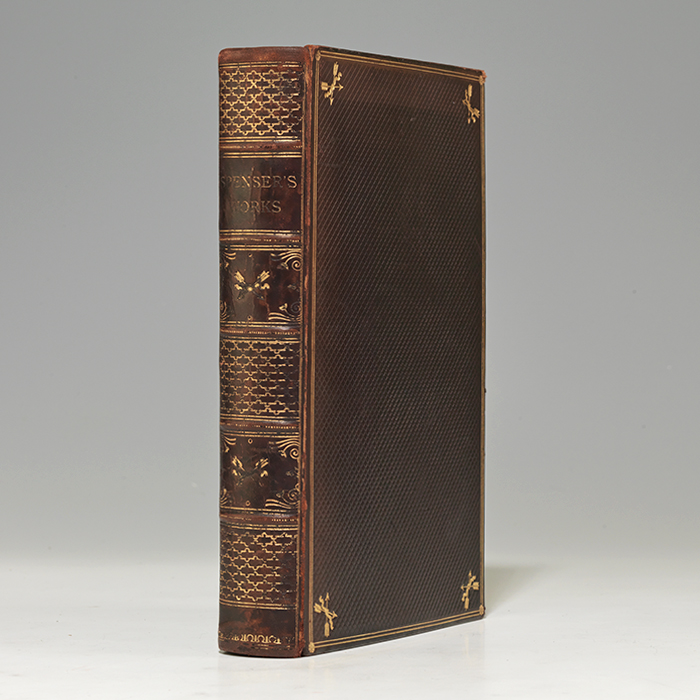
WITH BEAUTIFUL AND SCARCE TRIPLE EDGE PAINTINGS FEATURING A PORTRAIT OF EDMUND SPENSER AND CHIVALRIC SCENES
SPENSER, Edmund. The Works of Edmund Spenser, with A Selection of Notes from Various Commentators; and a Glossarial Index: To Which Is Prefixed Some Account of the Life of Spenser, by the Rev. Henry John todd, M.A. London: George Routledge, circa 1870. Thick octavo, 19th-century full diced burgundy morocco, elaborately gilt-decorated spine and covers, raised bands, marbled endpapers, all edges gilt, triple edge painting. $2000.
Later edition of Spenser's complete works, with frontispiece portrait of Edmund Spenser and vignette title page, beautifully bound in full morocco-gilt with a scarce triple edge painting depicting Edmund Spenser and several scenes of medieval knights and ladies.
"Although marking the fore-edge of a book had been done for centuries, it is often thought the development of the hidden fore-edge painting began in the mid-17th century by London bookbinders Stephen and Thomas Lewis. It grew more renowned under the auspices of King Charles II's royal bookbinder… The popularization of the art form, however, is most closely associated with Edwards of Halifax, an 18th–early 19th-century bookbinding family located in Pall Mall, London. Bookbinders like Edwards of Halifax hired artists to paint scenes on the edges. These artists would use watercolor, and then the edges were typically decorated in gilt… There is nothing quite like seeing a fore-edge painting seemingly appear out of nowhere. It is even more astonishing when fanning the pages in one direction and seeing an image appear, and then seeing a completely different painting when fanning the pages in the opposite direction. These are rightly called double fore-edge paintings… [T]here are not many surviving books with double fore-edge paintings" (New York Public Library). Fore-edge paintings continued to be produced well into the 20th century. This volume has rare triple edge paintings (on all three edges with the top and bottom revealed by fanning the corners). The fore-edge painting is a portrait of Edmund Spenser set against a jousting scene with the other two sides featuring knights and ladies. Armorial bookplate of James Edward Cowell Welldon, an English clergyman and scholar. Welldon was the headmaster of Harrow—to which the bookplate alludes. He was later honorary chaplain then Chaplain in Ordinary to Queen Victoria. After returning briefly to academia, he was appointed Bishop of Calcutta, returning after a controversy-plagued term to become a canon of Westminster, Dean of Manchester, and then Dean of Durham. Welldon was generally unpopular with everyone except his Harrow students (who called him "Porker") and earned sufficient notoriety that E.M. Forster wrote a satirical poem regarding Bishop Welldon after the bishop criticised Labour M.Ps for profanity..
Interior generally fine and only mild toning to extremities and a bit of wear to spine. A near-fine copy.